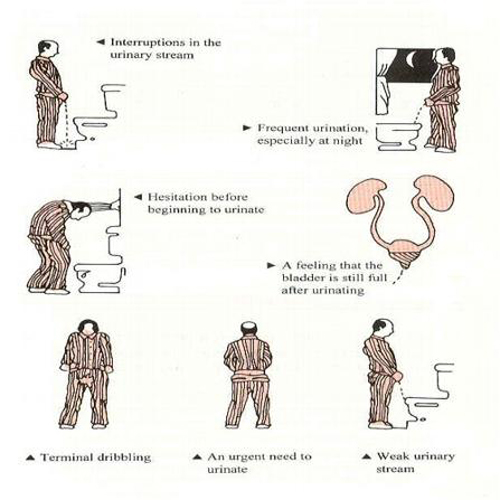
It is not uncommon for the prostate to begin to enlarge in men around age 40. Slowly and discreetly, this walnut sized gland begins to swell. The prostate is located just before the rectum and just behind the testicles. The prostate sits right next to the urethra, and as is swells, it is not uncommon for it to exude pressure against the urethra and cause urinary tract problems. Most men do not have prostate problems until they reach the age of 60, although it can happen for some earlier. at 40 the prostate begins to swell which eventually causes the condition known as benign prostatic hyperplasia.
Most men with an enlarged prostate have no symptoms, especially in the beginning. Over time symptoms such as frequent need to urinate, a strong urge to urinate, the sensation of not having the bladder emptied when urinating, dribbling or dripping, leaking, difficulty starting the urine flow, weak stream, and urinating several times throughout the night. if there is blood in the urine, it is important that a physician be contacted immediately.
The prostate naturally wraps around the urethra, and while it is unclear exactly why it grows larger with age, the prostate slowly wraps tighter around the urethra, causing in a sense a strangulation of the urethra. this causes the symptoms of an enlarged prostate. Since the prostate also sits just below the bladder, it is not uncommon for there to be added bladder pressure as the prostate grows. this can add to the sensation of needing to urinate more frequently and at night.
On occasion, the prostate can contract around the urethra tight enough to cause urinary tract infections. In rare instances, it can contract so tightly that the man can no longer urinate. this is known as acute urinary retention and would require emergency medical attention. Fever, chills, lower back pain, can all indicate complications and should be examined by a physician immediately.
Diagnosis of enlarged prostate requires a physical exam by a physician to determine that there are not underlying or various causes of the symptoms. a digital rectal exam is necessary, which entail the physician examining the prostate by inserting their fingers via a gloved and lubricated hand, inside the rectum to feel the prostate. a urinalysis may be performed to rule out a urinary tract infection. Blood tests to rule out kidney problems and prostate cancer are likely to be performed as well. many men prefer to visit a specialist, such as urologist for the diagnosis to rule out any possibility of prostate cancer.
Treatment may not be recommended at all if the symptoms are mild. it is more than likely that annual exams will be necessary to rule out any worsening of the condition or the development of complications. if symptoms are severe or complications set in, it is likely that the physician will determine whether medication is appropriate or the removal of the prostate altogether is more appropriate. Removing the prostate is considered a last resort. while medical science understands many of the prostate gland’s function, not all functions have been determined. other surgical options are available, such as the scraping away of the core of the prostate in order to make it smaller. Transurethral microwave thermotherapy is a new and becoming a more common treatment for enlarged prostate. it is considered a minimally invasive procedure and has shown fairly positive results in the early stages. The microwaves are used to produce enough heat to destroy some of the prostate tissue. other surgical procedures are being developed regularly.
When men learn to listen to their body’s needs often the symptoms of enlarged prostate can be reduced. Urinating as soon as the urge hits, and completely emptying of the bladder are simple steps that can be taken to eliminate a few of the symptoms associated with enlarged prostate. good nutrition and exercise can help ward off enlarged prostate, but there are no guarantees.
Enlarged prostate is a fairly common problem that men experience. while the medical exams and tests required to determine whether or not the prostate is enlarged are not pleasant, it is never a good idea to let the enlarged prostate go undetected. this may lead to more significant complications.